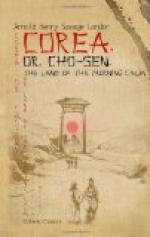[Illustration: MOUNT NANZAM]
The ground in and around Seoul is very hilly. The wall that surrounds the capital uncoils itself, like a gigantic snake, up and down the slopes of high bluffs, and seems a very marvellous work of patient masonry when it is borne in mind that some of the peaks up which it winds its way are so steep that even climbing on foot is not an easy task. The height is not uniform, but where it is highest it reaches to over thirty feet. The North Gate, for instance, is at a much higher level than the town down below, and it is necessary to go up a steep road to reach it. From it, a very good idea is obtainable of the exact situation of Seoul. Down in the valley, a narrow one, lies the town itself, completely surrounded by hills, and even mountains, covered with thick snow during the winter months.
The wall, several miles long, goes over the hill ridges far above the level of the town, except towards the west, where it descends to the valley, and is on almost level ground, as far as the East Gate. It has a rampart in which holes have been pierced, for the defence of the town by archers and gunners; and, to let out the water of the streams, which intersect the town, low arches have been cut in the wall, provided with strong iron bars, and a solid grating through which no man can penetrate. Outside the town, bridges of masonry have been constructed; for instance, there is one of four arches, a short distance from the North Gate, being the continuation of a portion of the wall protecting the river valley on the north of Seoul. Not far from this bridge, is a monastery, and a small temple with curled-up roof supported by columns, painted red and green. The latter protects an enormous block of stone upon which has been carved a large image of Buddha, the surface of which has been painted white. When I saw it, close by the river side, with the sun shining on it, and its image reflected in the limpid ice of the frozen river, the sight was indeed quite a picturesque one.
Towards the south side of Seoul, and within the city wall, rises in a cone-like fashion a high hill called Mount Nanzam. One cannot help feeling interested about this hill, and for many reasons. In the first place, it is most picturesque; secondly, it is a rare thing to find a mountain rising in the centre of a town, as this one does; thirdly, from the summit of this particular hill a constant watch is kept on the state of affairs all over the kingdom.
The mode of accomplishing the last-mentioned object is as ingenious as it is simple. It is shortly this. On the summit of Mount Nanzam a signal station is placed—a miserable shed, in which the watchmen live. In front of this, five piles of stones have been erected, upon which, by means of the “Pon-wa,” or fire-signals, messages are conveyed and transmitted from one end of the Corean kingdom to the other. Now, it is on these five piles of stones that the safety of the Land of the




